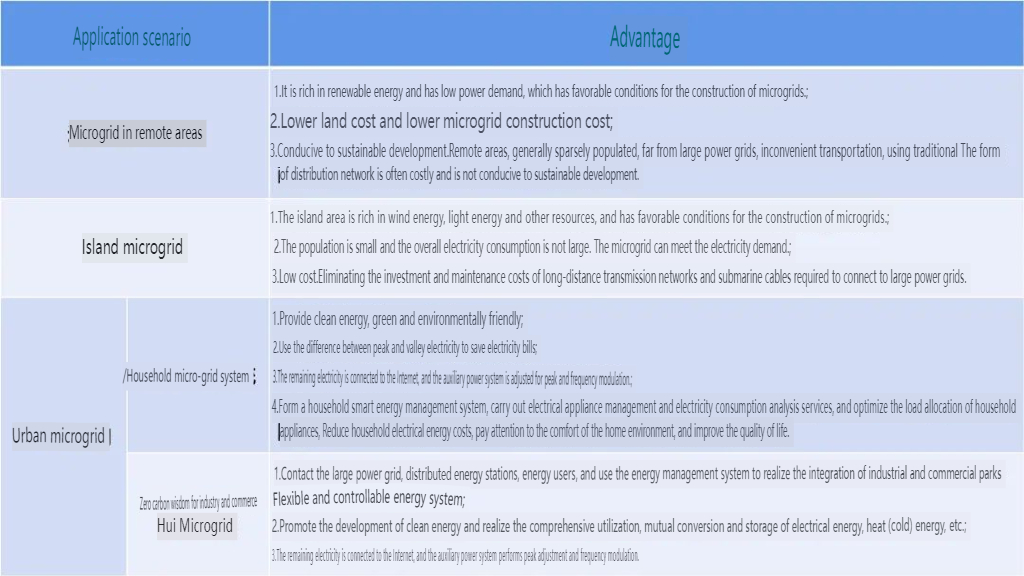What is a Micro-Grid?
A micro-grid is a small-scale power system composed of distributed power sources, loads, energy storage, power distribution and transformation, and control systems. Despite its small size, it is fully functional, capable of generation, distribution, and consumption of electricity. It can autonomously control, protect, and manage itself, optimizing energy within the grid.
The Difference Between Micro-Grid and Large Grid
Functional and Structural Differences
1. Distributed Power Sources: Micro-grids primarily rely on distributed power sources, using energy storage systems and control devices to regulate and meet load demands. 2. Independent Operation: Micro-grids can quickly disconnect from the large grid in case of faults and rely on their own capacity to continue supplying power to critical loads. 3. Planning and Design: The design of micro-grids is based on comprehensive energy use, resource distribution, and existing network conditions to ensure economic efficiency, reliability, and environmental sustainability.
Thus, from the perspectives of energy saving, environmental protection, and cost efficiency, micro-grids offer innovative solutions.
Why Build a Micro-Grid?
Despite the mature technology of traditional large grids, building micro-grids remains essential. Micro-grids can effectively integrate renewable energy and address major issues in distributed power generation. Renewable energy sources like solar and wind power are intermittent and random, often causing voltage and frequency instability that can severely impact the large grid. Research shows that integrating distributed power sources into the grid as micro-grids, supporting each other with the large grid, is an effective way to maximize their potential.
Micro-grids are particularly advantageous in areas not covered by the large grid, compensating for its deficiencies.
Functions of a Micro-Grid
1. Local Consumption and Energy Efficiency: Micro-grids utilize distributed energy sources like natural gas, photovoltaics, and wind power internally. Generally, micro-grids have smaller capacities with dispersed power sources close to the load, enabling local consumption and balance while allowing energy exchange with the large grid. 2. Single Point Connection, Reducing Impact on the Large Grid: Micro-grids exchange power with the grid through a single connection point, avoiding multiple direct connections of distributed power sources to the grid. Micro-grids mainly supply power internally and have negligible impact on the grid. 3. Enhancing Power Reliability and Meeting Energy Needs: With advanced control methods and numerous power electronics devices, micro-grids connect distributed power sources, energy storage devices, and controllable loads, operating in both grid-connected and independent modes to ensure stable and safe operation.
Classification of Micro-Grids
Based on their connection to the large grid, micro-grids are classified into grid-connected and standalone types:
1. Grid-Connected Micro-Grids: Typically operate connected to the grid, relying on the large grid to stabilize voltage and frequency and enabling bidirectional energy exchange. They can switch to independent operation during large grid faults to ensure power supply to critical loads. 2. Standalone Micro-Grids: Operate independently without connecting to the large grid, relying solely on distributed power sources and energy storage systems for load supply. They often use internal diesel generators and storage systems to stabilize voltage and frequency.
Applications of Micro-Grids
In economically developed areas covered by the large grid, micro-grid power supply costs are generally higher, lacking economic viability. Particularly for grid-connected micro-grids, competition with the large grid is challenging.
However, in areas not covered by the large grid, such as islands, remote regions, suburban areas, and tourist spots, micro-grids have significant advantages, making the development of standalone micro-grids crucial.
Development Prospects of Micro-Grids
The future holds substantial growth potential for micro-grids. In recent years, China has introduced multiple policies to support the development of the micro-grid industry, promoting the construction of micro-grid projects. These policies not only advance micro-grid technology but also enable broader applications.
Micro-grids not only offer solutions for the efficient utilization of distributed power sources but also pave the way for the intelligent and sustainable development of future energy systems.
If you're interested in learning more about our solar energy storage offerings, we encourage you to explore our product line. We offer a range of panels and battery that are designed for various applications and budgets, so you're sure to find the right solution for your needs.
Website: www.fgreenpv.com
Email: Info@fgreenpv.com
WhatsApp: +86 17311228539
Media Contact
Company Name: GreenPower
Email: Send Email
Country: China
Website: https://www.fgreenpv.com/

